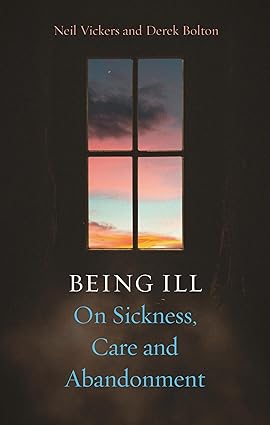Commentary by Maria Giulia Marini
Epidemiologist and Counselor

“Being Ill” by Neil Vickers and Professor Derek Bolton of King’s College London is a must-read-a powerful, interdisciplinary masterpiece. This book beautifully weaves together epidemiology, the most current neuroscientific and psychological theories, and the philosophy of narrative medicine to explore what it truly means to fall ill-not only physically, but emotionally, socially, and existentially.
It offers a crucial critique of WEIRD societies (Western, Educated, Individualistic, Rich, and Democratic), which, having fostered what Zygmunt Bauman called a liquid society, often push illness out of sight. In these cultures, the ill are seen as disruptions to an ideal of autonomy, efficiency, and control. There is a deep discomfort with vulnerability, and as a result, sick individuals are often marginalized or avoided.
In contrast, Mediterranean societies still value relational closeness-where family and friendship networks provide important safe spaces for those who are suffering. In these cultures, illness is not seen as something shameful or private but as a shared experience, to be carried together. This comparison is essential for reimagining how we can humanize care and resist the isolating effects of individualism.
The structure of the book is well-designed and intellectually generous. Its key chapters-Emerging Illness, The Care, The Pariah Syndrome (a powerful reflection on stigma and discrimination), and Biopsychosocial Beings-each offer a fresh, interdisciplinary perspective. The authors go beyond the biomedical model, showing how illness is a destabilizer of our inner balance, something that unsettles not just the body but also our identities and memories and enters in our life as a trouble, paralyzing an entire system. When illness strikes, it shakes the foundation of what we consider normal-and that discomfort is felt not only by the person who is ill, but by everyone around them who might reject or accept the illness created problems.
The chapter The Care is particularly illuminating. It explains that care unfolds in a three-step progression: first, care about, which means becoming aware of another’s suffering and recognizing it as important; then, care for, which is accepting responsibility for responding to that need; and finally, caregiving, which is the concrete act of helping. This structure beautifully parallels the stages of Nonviolent Communication (NVC): first, distinguishing the need behind the experience; then, deeply listening to the patient’s narrative; and finally, offering caregiving that can support a transformation-from an old, often painful narrative, into a new, empowering one. This reframing-through empathy, attentive presence, and moral responsibility-is what makes care not only a technical action but a “good” relationship.
Vickers and Bolton also bring forward a profound three-fold process for responding to illness: mirroring – we experience empathy by seeing ourselves in the other, holding – we create the bond, a secure and compassionate space that acknowledges vulnerability, and compassion – we act with care, doing something meaningful for the person who is ill.
This process, while discussed in a clinical and psychological context, is deeply rooted in our biological and relational evolution, particularly in the mother-child relationship-one of the most ancestral form of care. It is through these primal patterns that we learn to co-regulate, soothe, and connect. This process also activates neurochemical responses-serotonin, oxytocin, and dopamine-creating an intersubjective field of well-being that nourishes both the caregiver and the person being cared for.
A particularly moving chapter explores the biopsychosocial model through an epidemiological lens, showing how social determinants of health-such as poverty, unemployment, exclusion, or discrimination have measurable, deeply embodied consequences. Ignoring these stories reduces health to biology alone and reinforces a bio reductionist model that is both inadequate and stigmatizing.
By applying these frameworks, we can shift from poor standard healthcare toward relational and sustainable care models. When we deeply listen to the stories of those who are ill-not just with clinical competence, but with true presence, narrative skills and empathy-we honor the complexity of their experience and may help them.
Nonviolent Communication teaches us to identify underlying needs, listen without judgment, and respond with care rather than control. Narrative medicine offers a structure for patients to reshape their stories-often from pain and original chaos into quest and meaning. When combined, as in my current research work, these approaches allow both the patient and the caregiver to engage in a transformative dialogue that builds trust, emotional safety, and possibly wellbeing.
“Being Ill” is a call: it challenges healthcare professionals, and aid providers us to go beyond technical solutions. It asks us to accompany the ill person, and their caregivers to stand in solidarity with their suffering, and to create safe relational spaces where new narratives of meaning can emerge. Illness is indeed trouble-but when met with presence, connection, and compassion, it might become a deeply human existential experience.
Gratitude to Neil Vickers and Derek Bolton who through this book teach us to be better carers.
